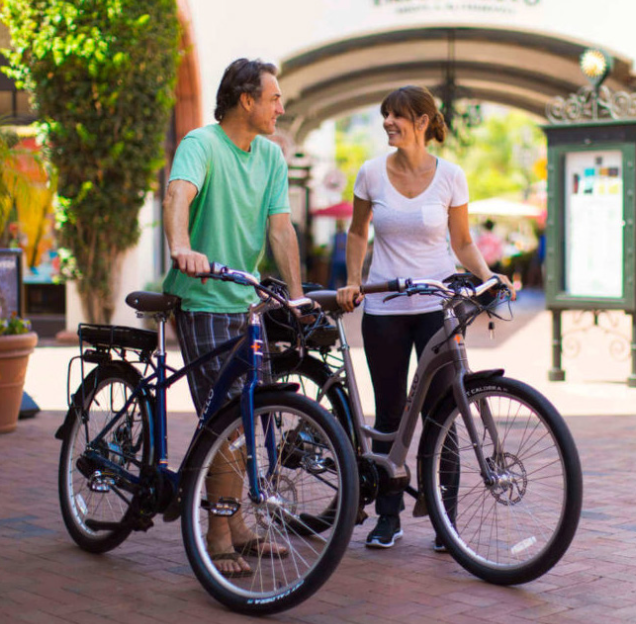Continue Cycling for Lifelong Wellness
There are all sorts of incredible reasons to continue exploring the world of cycling through- out your entire life. Here are some of the most exciting.
Cycling and Wellness
A rapidly growing body of data proves that cycling is a powerful way to prevent the onset of health complications while also extending life expectancy. Here are some highlights of what the data tells us:
- One study found that former Tour de France cyclists lived to be an average of 81.5 years old while the general population lived an average of 73.5 years. And as Bicycling pointed out in a recent article, other similar studies have shown that even casual cyclists enjoy similar benefits, typically living 3-14 months longer than people who don’t cycle.
- A study published in 2017 found that frequent bicycle commuting can cut the risk of developing heart disease and cancer almost in half. Researchers working on this project concluded that cycling “was associated with a lower risk of cardiovascular disease, cancer, and all causes mortality.”
- Researchers at the Mayo Clinic found that intense cycling workouts promote increased cellular health and can produce major anti-aging benefits.
- A 2018 study found that cycling up to 60 minutes per week “was associated with lower risk of all-cause mortality.” Outcomes were especially positive for those “cycling late in mid-life.”
- Cycling is an excellent way to raise your heart rate, burn calories, and lower body weight, all of which experts say help decrease your chance of developing diabetes, heart disease, certain types of cancer, and other health complications.
The key to enjoying these long-term benefits is to continue cycling throughout your entire life. Fortunately, there are numerous ways to branch out and explore different types of cycling. The rest of this chapter will give you some ideas for how to expand your cycling experience.
4 Ways to Explore the Wide World of Cycling
1. LOG EPIC MILES ON A LONG DISTANCE BIKE TOUR
If you’re captivated by the allure of the open road, you might fall in love with long distance bicycle touring. This type of riding is all about completing super long rides over the course of several days, weeks, or months. Bike tourists either pack overnight gear with them on their bikes or ride alongside a sag wagon with support gear.
The best way to prepare for the long hours of pedaling that make up a day in the life of a bicycle tourist is to start increasing the number of hours you ride each week. Gradually scale up the length of your rides, until you’re completing at least one or two 6-hour rides per week. At that point, you’ll be as ready as you’ll ever be to start logging huge miles on a tour.
If you’ll be packing your own gear, you need a way to haul everything, typically either a rear rack with panniers or a lightweight bicycle trailer.
2. INCORPORATE CYCLING INTO YOUR VACATIONS
When you go on vacation, look for ways to incorporate cycling into your plans. This is an easy and very fun way to keep yourself consistently in the saddle. If you’re worried about whether or not you’re in good enough shape to enjoy cycling on a vacation, start increasing the amount of time you spend pedaling each week. Beginning four weeks before your vacation, start increasing your cycling time by 10%-25% every week. In general, if you’re accustomed to riding longer than you will be on your vacation, you’ll be in a much better position to view your leisurely rides as fun rather than hard work.
3. HIT THE TRAILS
If you’ve only ridden your bike on roads and paved bike trails, and you’re looking for a way to expand your cycling repertoire, give mountain biking a shot.
Mountain biking is different from regular riding in some important ways. Most notably, you’ll log significantly fewer miles on a mountain bike ride than you will on a road or paved trail since the terrain is so much more challenging. Similarly, mountain biking tends to be much more technically demanding than normal road riding, requiring you to navigate rough trails, steep climbs and descents, rocks, roots, and other obstacles.
With all that in mind, be sure you invest in an actual mountain bike. Anything else will not be sturdy enough to handle off-road trails effectively. Start out riding easier trails. When you can complete these easy trails all the way through, and you’re feeling confident in your physical fitness and technical skills, start exploring intermediate trails and continue advancing to more challenging, expert-level trails.
4. RIDE YOUR BIKE TO CROSS TRAIN FOR OTHER SPORTS
If you regularly engage in other physical activities such as running, swimming, or another sport, consider adding cycling into the mix of your other exercise routines. Doing so will give you better overall health outcomes and can help you perform even better in your other sports. To use cycling as a form of cross training for a different sport, complete the following cycling workout once per week:
| HOW TO PEDAL | HOW LONG |
| 1. Warm-up: easy pace, Zone 1-2 | 10-15 minutes |
| 2. Sprint: as hard and fast as you can | 1 minute |
| 3. Recovery interval: easy pace, Zone 1-2 | 2 minutes |
| 4. Repeat steps 2-3 nine more times, for a grand total of 10 sets | 27 minutes |
| 5. Cool down: easy pace, Zone 1-2 |
10-15 minutes |
This cross training cycling workout was developed by triathlete Linsey Corbin and published at: Hadfield, Jenny. “How to Improve Running Performance with Cycling.” Runner’s World. July 15, 2015.

